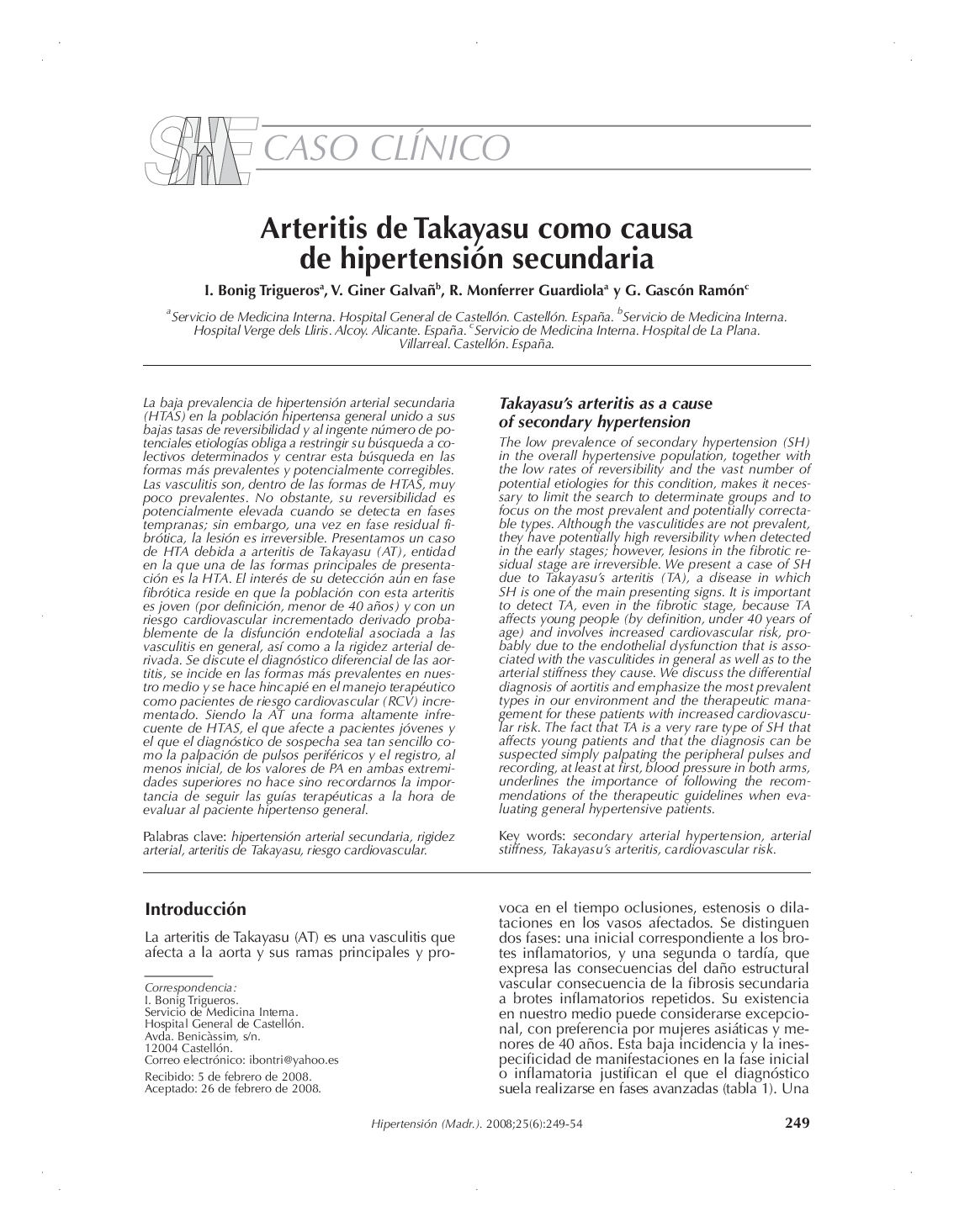| کد مقاله | کد نشریه | سال انتشار | مقاله انگلیسی | نسخه تمام متن |
|---|---|---|---|---|
| 2926007 | 1575787 | 2008 | 6 صفحه PDF | دانلود رایگان |

La baja prevalencia de hipertensión arterial secundaria (HTAS) en la población hipertensa general unido a sus bajas tasas de reversibilidad y al ingente número de potenciales etiologías obliga a restringir su búsqueda a colectivos determinados y centrar esta búsqueda en las formas más prevalentes y potencialmente corregibles. Las vasculitis son, dentro de las formas de HTAS, muy poco prevalentes. No obstante, su reversibilidad es potencialmente elevada cuando se detecta en fases tempranas; sin embargo, una vez en fase residual fibrótica, la lesión es irreversible. Presentamos un caso de HTA debida a arteritis de Takayasu (AT), entidad en la que una de las formas principales de presentación es la HTA. El interés de su detección aún en fase fibrótica reside en que la población con esta arteritis es joven (por definición, menor de 40 años) y con un riesgo cardiovascular incrementado derivado probablemente de la disfunción endotelial asociada a las vasculitis en general, así como a la rigidez arterial derivada. Se discute el diagnóstico diferencial de las aortitis, se incide en las formas más prevalentes en nuestro medio y se hace hincapié en el manejo terapéutico como pacientes de riesgo cardiovascular (RCV) incrementado. Siendo la AT una forma altamente infrecuente de HTAS, el que afecte a pacientes jóvenes y el que el diagnóstico de sospecha sea tan sencillo como la palpación de pulsos periféricos y el registro, al menos inicial, de los valores de PA en ambas extremidades superiores no hace sino recordarnos la importancia de seguir las guías terapéuticas a la hora de evaluar al paciente hipertenso general.
The low prevalence of secondary hypertension (SH) in the overall hypertensive population, together with the low rates of reversibility and the vast number of potential etiologies for this condition, makes it necessary to limit the search to determinate groups and to focus on the most prevalent and potentially correctable types. Although the vasculitides are not prevalent, they have potentially high reversibility when detected in the early stages; however, lesions in the fibrotic residual stage are irreversible. We present a case of SH due to Takayasu's arteritis (TA), a disease in which SH is one of the main presenting signs. It is important to detect TA, even in the fibrotic stage, because TA affects young people (by definition, under 40 years of age) and involves increased cardiovascular risk, probably due to the endothelial dysfunction that is associated with the vasculitides in general as well as to the arterial stiffness they cause. We discuss the differential diagnosis of aortitis and emphasize the most prevalent types in our environment and the therapeutic management for these patients with increased cardiovascular risk. The fact that TA is a very rare type of SH that affects young patients and that the diagnosis can be suspected simply palpating the peripheral pulses and recording, at least at first, blood pressure in both arms, underlines the importance of following the recommendations of the therapeutic guidelines when evaluating general hypertensive patients.
Journal: Hipertensión - Volume 25, Issue 6, December 2008, Pages 249-254